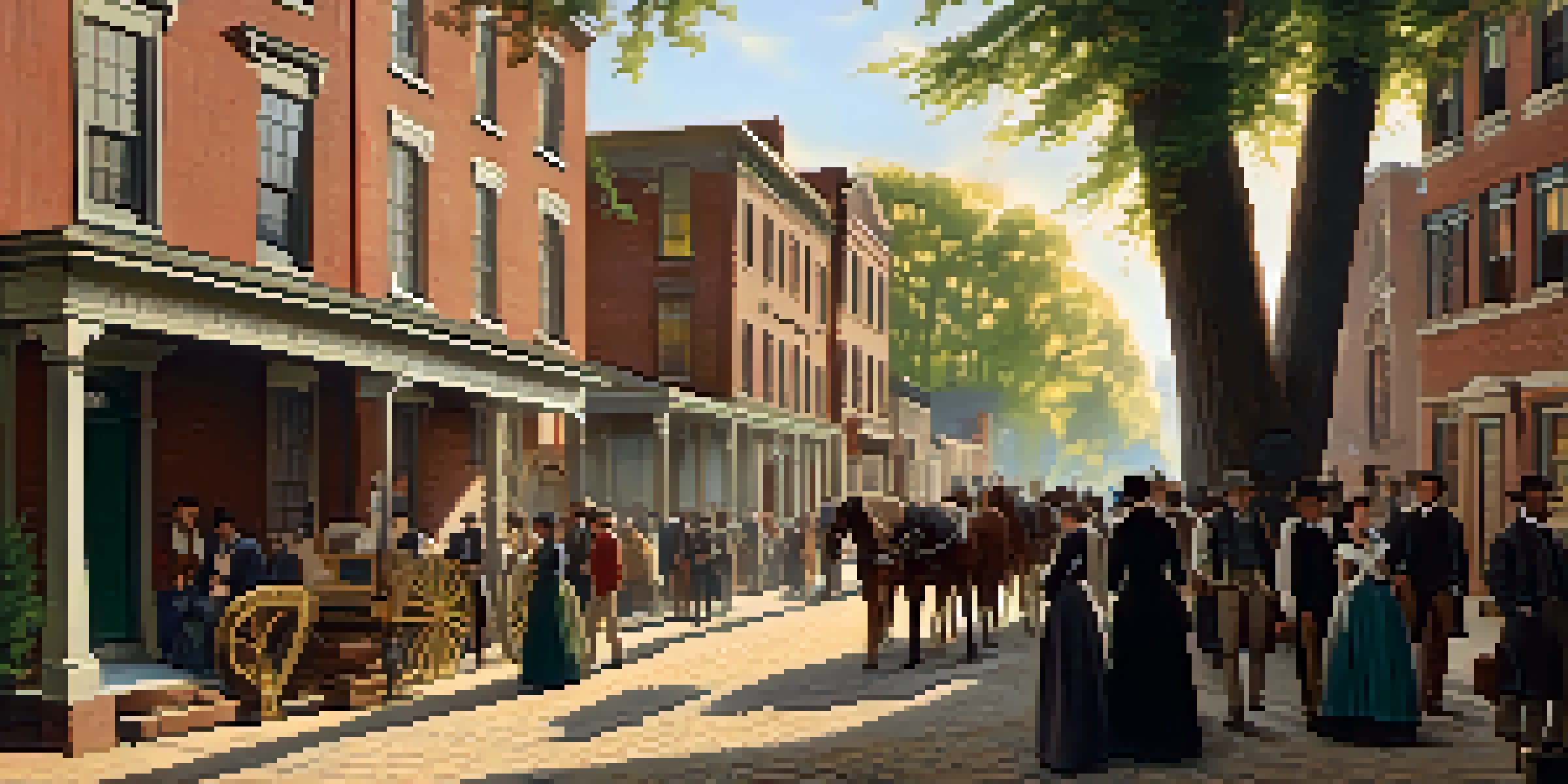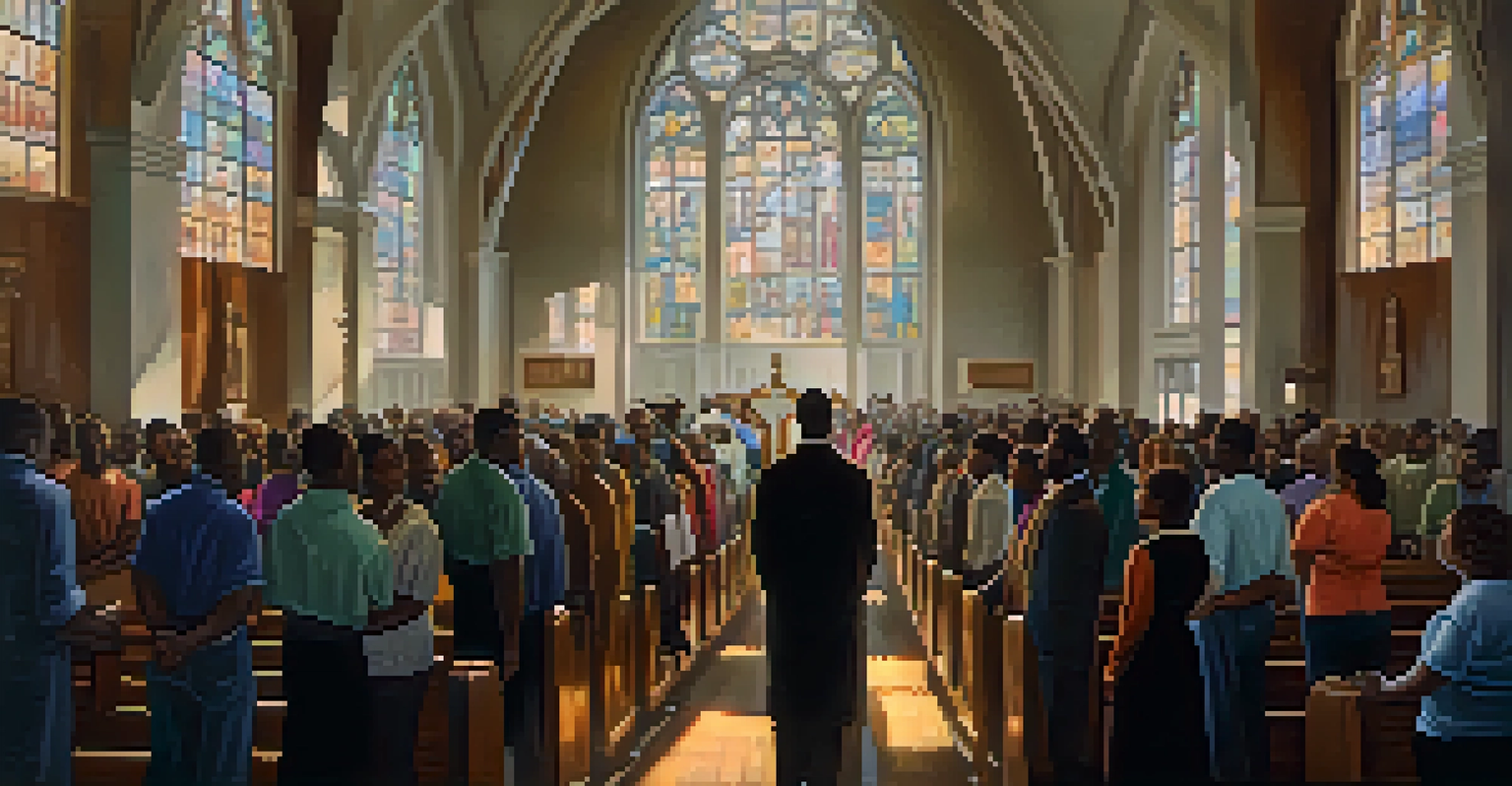Newark’s Role in the Underground Railroad

Newark: A Key Stop on the Underground Railroad
Newark, New Jersey, played a crucial role in the Underground Railroad, serving as a vital stop for many escaping enslaved individuals. Positioned just a stone's throw from New York City, it offered a strategic location for those seeking freedom. The city became a hub of activity, with secret routes and safe houses established to help fugitives on their journey to liberty.
I freed a thousand slaves I could have freed a thousand more if only they knew they were slaves.
Many local residents, both free and formerly enslaved, actively participated in this movement, often risking their lives to aid others. They created a network of support, providing shelter, food, and guidance to those in need. This community spirit exemplified the courage and resilience of Newark's residents during a tumultuous time in American history.
The significance of Newark in the Underground Railroad is not just a footnote in history; it highlights the collective effort of individuals committed to justice. Their bravery set the stage for future civil rights movements, demonstrating that even in the darkest times, there were those willing to fight for freedom.
Key Figures in Newark's Underground Railroad Network
Several notable figures emerged from Newark's Underground Railroad efforts, each with unique stories of bravery and determination. Among them was Harriet Tubman, who, while not a resident, often passed through the area, inspiring many to join the fight for freedom. Local abolitionists, such as Thomas Branch and the members of the Newark Anti-Slavery Society, played pivotal roles in organizing efforts and providing resources.

These individuals not only aided fugitives but also worked tirelessly to raise awareness about the injustices of slavery. They held meetings, published pamphlets, and rallied the community to support abolitionist causes. Their collective activism created a ripple effect that extended beyond Newark, influencing public opinion throughout the region.
Newark's Role in the Underground Railroad
Newark served as a crucial stop on the Underground Railroad, providing vital support and safe havens for those escaping slavery.
The legacy of these key figures serves as a reminder of the power of individual action. Their commitment to the cause of freedom helped to forge a path for future generations, emphasizing that every effort counts in the fight against oppression.
The Underground Railroad's Impact on Newark's Community
The Underground Railroad significantly transformed Newark's community dynamics, fostering a spirit of solidarity among its residents. As more fugitive slaves sought refuge, neighborhoods began to band together, creating a network of support that transcended racial boundaries. This collaboration helped establish a sense of unity against the prevailing injustices of slavery.
The arc of the moral universe is long, but it bends toward justice.
Moreover, the presence of escaping individuals enriched Newark's cultural tapestry, introducing diverse stories and experiences that shaped the community. As these new residents settled in, they contributed to the local economy and brought with them unique cultural traditions. The resulting blend of cultures created a vibrant community that celebrated both resilience and diversity.
The impact of the Underground Railroad in Newark is still felt today, as the city continues to honor its history through various programs and memorials. This rich heritage serves as a reminder of the importance of community action in the face of adversity, encouraging current and future generations to stand against oppression.
Safe Houses: Sanctuaries for Freedom Seekers
Safe houses were essential to the success of the Underground Railroad, providing critical refuge for those in transit. Newark had numerous locations that offered shelter, often hidden in plain sight within the homes of sympathetic residents. These safe havens were vital for fugitives to rest, regroup, and plan their next steps on the journey to freedom.
The owners of these safe houses demonstrated immense bravery, often risking their own safety by harboring escaped slaves. Many were connected to abolitionist movements and understood the moral imperative of their actions. They transformed their homes into sanctuaries, ensuring that those seeking freedom had a safe space to recuperate and regain their strength.
Legacy of Community Action
The brave efforts of Newark's residents during the Underground Railroad laid the groundwork for future civil rights movements and community solidarity.
The legacy of these safe houses is profound, as they symbolize the compassion and courage of those who opposed slavery. They remind us that even in the face of systemic injustice, ordinary people can make extraordinary contributions to the fight for freedom.
The Role of Churches in Supporting Escaped Slaves
Churches in Newark played a significant role in the Underground Railroad, serving as both meeting places and shelters for escaping slaves. Many congregations were deeply committed to the abolitionist cause, using their resources to support those seeking freedom. Churches often provided food, clothing, and safe passage to the next stop on the journey.
The spiritual leaders of these churches were often vocal advocates for social justice, preaching the values of equality and human rights. They inspired their congregations to take action, mobilizing community support for the Underground Railroad. This united front helped to create a strong network of allies dedicated to ending slavery.
The commitment of Newark's churches to the Underground Railroad reflects the broader relationship between faith and activism. Their legacy continues to inspire contemporary movements for social justice, highlighting the enduring impact of community solidarity in the fight against oppression.
Newark's Underground Railroad Legacy Today
Today, Newark's legacy as a pivotal player in the Underground Railroad is celebrated and preserved through various historical sites and educational programs. Museums and local organizations work tirelessly to keep this important history alive, offering tours, lectures, and events that highlight Newark's role in the fight for freedom. These initiatives help to educate the public and ensure that the sacrifices of those who came before are not forgotten.
Community events often commemorate significant milestones in the Underground Railroad's history, allowing residents to reflect on the past while forging connections with one another. These gatherings serve to reinforce the values of compassion, justice, and community engagement that are central to Newark's identity.
Education and Awareness Initiatives
Educational programs in Newark continue to raise awareness about its Underground Railroad history, inspiring ongoing conversations about social justice.
By acknowledging its history, Newark continues to foster a culture of awareness and activism. This ongoing commitment to learning from the past empowers current and future generations to stand up against injustice, creating a brighter future for all.
Educational Efforts to Raise Awareness
Education plays a vital role in preserving the history of Newark's involvement in the Underground Railroad. Local schools and organizations have developed programs aimed at teaching students about this significant part of their heritage. Through interactive lessons and field trips to historical sites, young people are encouraged to engage with the past and understand its relevance to contemporary issues.
In addition to school programs, community workshops and seminars provide opportunities for residents to learn more about the Underground Railroad. These initiatives often feature guest speakers, including historians and descendants of those involved in the movement, sharing personal stories that bring history to life. This engagement fosters a deeper understanding of the struggles and triumphs faced by those fighting for freedom.

By prioritizing education, Newark ensures that the story of the Underground Railroad remains a vital part of its community narrative. This commitment serves not only to honor the past but also to inspire ongoing conversations about equity, justice, and the importance of standing up against modern-day injustices.
Continuing the Fight for Social Justice
As we reflect on Newark's significant role in the Underground Railroad, it's essential to recognize the ongoing relevance of this history in today's social justice movements. The courage and determination of those involved in the Underground Railroad continue to inspire activists who strive for equality and justice. Their legacy reminds us that the fight against oppression is far from over.
Modern movements often draw parallels to the struggles faced by fugitive slaves, highlighting issues such as racial inequality, immigration rights, and systemic injustice. By understanding the past, we can better navigate the challenges of the present, learning valuable lessons from those who fought for freedom and equality.
Newark stands as a testament to the power of community action and solidarity in the face of adversity. By honoring its history, the city not only acknowledges the sacrifices made by those who came before but also empowers current and future generations to continue the fight for a more just and equitable society.